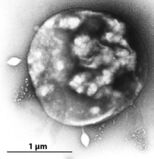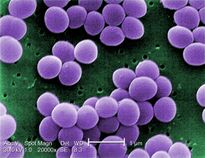Biology:Three-domain system

The three-domain system is a biological classification introduced by Carl Woese, Otto Kandler, and Mark Wheelis in 1990[1] that divides cellular life forms into three domains, namely Archaea, Bacteria, and Eukarya. The key difference from earlier classifications such as the two-empire system and the five-kingdom classification is the splitting of Archaea from Bacteria as completely different organisms. It has been challenged by the two-domain system that divides organisms into Bacteria and Archaea only, as Eukaryotes are considered as one group of Archaea.[2][3][4]
Background
Woese argued, on the basis of differences in 16S rRNA genes, that bacteria, archaea, and eukaryotes each arose separately from an ancestor with poorly developed genetic machinery, often called a progenote. To reflect these primary lines of descent, he treated each as a domain, divided into several different kingdoms. Originally his split of the prokaryotes was into Eubacteria (now Bacteria) and Archaebacteria (now Archaea).[5] Woese initially used the term "kingdom" to refer to the three primary phylogenic groupings, and this nomenclature was widely used until the term "domain" was adopted in 1990.[1]
Acceptance of the validity of Woese's phylogenetically valid classification was a slow process. Prominent biologists including Salvador Luria and Ernst Mayr objected to his division of the prokaryotes.[6] Today, very few scientists still accept the concept of a unified Prokarya.[7]
Classification
The three-domain system adds a level of classification (the domains) "above" the kingdoms present in the previously used five- or six-kingdom systems. This classification system recognizes the fundamental divide between the two prokaryotic groups, insofar as Archaea appear to be more closely related to eukaryotes than they are to other prokaryotes – bacteria-like organisms with no cell nucleus. The three-domain system sorts the previously known kingdoms into these three domains: Archaea, Bacteria, and Eukarya.[2]
Domain Archaea
The Archaea are prokaryotic, with no nuclear membrane, but with biochemistry and RNA markers that are distinct from bacteria. The Archaeans possess unique, ancient evolutionary history for which they are considered some of the oldest species of organisms on Earth, most notably their diverse, exotic metabolisms.
Some examples of archaeal organisms are:
- methanogens – which produce the gas methane
- halophiles – which live in very salty water
- thermoacidophiles – which thrive in acidic high-temperature water
Domain Bacteria
The Bacteria are also prokaryotic; their domain consists of cells with bacterial rRNA, no nuclear membrane, and whose membranes possess primarily diacyl glycerol diester lipids. Traditionally classified as bacteria, many thrive in the same environments favored by humans, and were the first prokaryotes discovered; they were briefly called the Eubacteria or "true" bacteria when the Archaea were first recognized as a distinct clade.
Most known pathogenic prokaryotic organisms belong to bacteria (see[8] for exceptions). For that reason, and because the Archaea are typically difficult to grow in laboratories, Bacteria are currently studied more extensively than Archaea.
Some examples of bacteria include:
- "Cyanobacteria" – photosynthesizing bacteria that are related to the chloroplasts of eukaryotic plants and algae
- Spirochaetota – Gram-negative bacteria that include those causing syphilis and Lyme disease
- Actinomycetota – Gram-positive bacteria including Bifidobacterium animalis which is present in the human large intestine
Domain Eukarya
Eukaryota are organisms whose cells contain a membrane-bound nucleus. They include many large single-celled organisms and all known non-microscopic organisms. The domain contains, for example:
- Holomycota – mushrooms and allies
- Viridiplantae - green plants
- Holozoa - animals and allies
- Stramenopiles – includes brown algae
- Amoebozoa - solitary and social amoebae
- Discoba - includes euglenoids
Niches
Each of the three cell types tends to fit into recurring specialities or roles. Bacteria tend to be the most prolific reproducers, at least in moderate environments. Archaeans tend to adapt quickly to extreme environments, such as high temperatures, high acids, high sulfur, etc. This includes adapting to use a wide variety of food sources. Eukaryotes are the most flexible with regard to forming cooperative colonies, such as in multi-cellular organisms, including humans. In fact, the structure of a eukaryote is likely to have derived from a joining of different cell types, forming organelles.
Parakaryon myojinensis (incertae sedis) is a single-celled organism known to be a unique example. "This organism appears to be a life form distinct from prokaryotes and eukaryotes",[9] with features of both.
Alternatives
Parts of the three-domain theory have been challenged by scientists including Ernst Mayr, Thomas Cavalier-Smith, and Radhey S. Gupta.[10][11][12]
Recent work has proposed that Eukaryota may have actually branched off from the domain Archaea. According to Spang et al. Lokiarchaeota forms a monophyletic group with eukaryotes in phylogenomic analyses. The associated genomes also encode an expanded repertoire of eukaryotic signature proteins that are suggestive of sophisticated membrane remodelling capabilities.[13] This work suggests a two-domain system as opposed to the three-domain system.[3][4][2] Exactly how and when archaea, bacteria, and eucarya developed and how they are related continues to be debated.[14][2][15]
See also
References
- ↑ 1.0 1.1 1.2 "Towards a natural system of organisms: proposal for the domains Archaea, Bacteria, and Eucarya". Proceedings of the National Academy of Sciences of the United States of America 87 (12): 4576–9. June 1990. doi:10.1073/pnas.87.12.4576. PMID 2112744. Bibcode: 1990PNAS...87.4576W.
- ↑ 2.0 2.1 2.2 2.3 Gabaldón, Toni (8 October 2021). "Origin and Early Evolution of the Eukaryotic Cell" (in en). Annual Review of Microbiology 75 (1): 631–647. doi:10.1146/annurev-micro-090817-062213. ISSN 0066-4227. PMID 34343017. https://doi.org/10.1146/annurev-micro-090817-062213. Retrieved 11 August 2022. ""A rooted version of this three-domain tree placed Archaea and Eukarya as sister clades, suggesting that eukaryotes were very distantly related to archaea and not more related to any specific group. More recently, phylogenetic analyses using more sophisticated models and expanded gene data sets have provided increasing support for an alternative tree topology in which the eukaryotic clade branches within Archaea, rather than next to it."".
- ↑ 3.0 3.1 Nobs, Stephanie-Jane; MacLeod, Fraser I.; Wong, Hon Lun; Burns, Brendan P. (2022). "Eukarya the chimera: eukaryotes, a secondary innovation of the two domains of life?" (in en). Trends in Microbiology 30 (5): 421–431. doi:10.1016/j.tim.2021.11.003. PMID 34863611. https://linkinghub.elsevier.com/retrieve/pii/S0966842X21002699.
- ↑ 4.0 4.1 Doolittle, W. Ford (2020). "Evolution: Two Domains of Life or Three?" (in en). Current Biology 30 (4): R177–R179. doi:10.1016/j.cub.2020.01.010. PMID 32097647.
- ↑ "Phylogenetic structure of the prokaryotic domain: the primary kingdoms". Proceedings of the National Academy of Sciences of the United States of America 74 (11): 5088–90. November 1977. doi:10.1073/pnas.74.11.5088. PMID 270744. Bibcode: 1977PNAS...74.5088W.
- ↑ Sapp, Jan A. (2009). The new foundations of evolution: on the tree of life. 95. New York: Oxford University Press. doi:10.1073/pnas.95.17.9720. ISBN 978-0-199-73438-2.
- ↑ Koonin, Eugene (2014). "Carl Woese's vision of cellular evolution and the domains of life". RNA Biology (RNA Biol.) 11 (3): 197–204. doi:10.4161/rna.27673. PMID 24572480.
- ↑ Eckburg, Paul B.; Lepp, Paul W.; Relman, David A. (2003). "Archaea and their potential role in human disease". Infection and Immunity 71 (2): 591–596. doi:10.1128/IAI.71.2.591-596.2003. PMID 12540534.
- ↑ "Prokaryote or eukaryote? A unique microorganism from the deep sea". Journal of Electron Microscopy 61 (6): 423–31. 2012. doi:10.1093/jmicro/dfs062. PMID 23024290.
- ↑ Gupta, Radhey S. (1998). "Life's Third Domain (Archaea): An Established Fact or an Endangered Paradigm?: A New Proposal for Classification of Organisms Based on Protein Sequences and Cell Structure.". Theoretical Population Biology 54 (2): 91–104. doi:10.1006/tpbi.1998.1376. PMID 9733652.
- ↑ Mayr, E. (1998). "Two empires or three?". Proc. Natl. Acad. Sci. USA 95 (17): 9720–9723. doi:10.1073/pnas.95.17.9720. PMID 9707542. Bibcode: 1998PNAS...95.9720M.
- ↑ Cavalier-Smith, Thomas (2002). "The neomuran origin of archaebacteria, the negibacterial root of the universal tree and bacterial megaclassification". Int J Syst Evol Microbiol 52 (1): 7–76. doi:10.1099/00207713-52-1-7. PMID 11837318.
- ↑ Spang, Anja (2015). "Complex archaea that bridge the gap between prokaryotes and eukaryotes". Nature 521 (7551): 173–179. doi:10.1038/nature14447. PMID 25945739. Bibcode: 2015Natur.521..173S.
- ↑ Callier, Viviane (8 June 2022). "Mitochondria and the origin of eukaryotes". Knowable Magazine. doi:10.1146/knowable-060822-2. https://knowablemagazine.org/article/living-world/2022/mitochondria-origin-eukaryotes. Retrieved 18 August 2022.
- ↑ McCutcheon, John P. (6 October 2021). "The Genomics and Cell Biology of Host-Beneficial Intracellular Infections" (in en). Annual Review of Cell and Developmental Biology 37 (1): 115–142. doi:10.1146/annurev-cellbio-120219-024122. ISSN 1081-0706. PMID 34242059.
de:Domäne (Biologie) fr:Domaine (biologie)
 |





